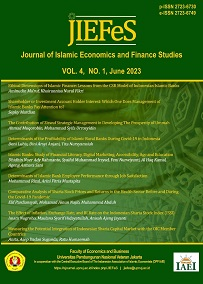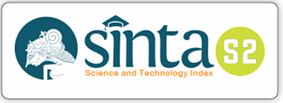Determinants of the Profitability of Islamic Rural Banks During Covid-19 in Indonesia
DOI:
https://doi.org/10.47700/jiefes.v4i1.5861Keywords:
Crisis, Financial Ratio, Internal Factor, Macroeconomics, ProfitabilityAbstract
The Return on Asset (ROA) value of Islamic rural banks (BPRS) keeps decreasing during the Covid-19 pandemic, specifically from 2020 to 2021. The ROA value of Sharia Commercial Bank and Sharia Business Unit also decreased in 2020 but increased in 2021. During the pandemic, many financial institutions were in trouble, but BPRS was still able to survive in the midst of a crisis. This phenomenon attracted some scholars to study the factors that made BPRS survive during a pandemic. This study aims to analyze the effect of internal and external factors on Islamic rural banks’ profitability from the second quarter of 2020 to the first quarter of 2022. The sample used consisted of 134 Islamic rural banks with complete data to be analyzed. This study used panel data regression with ROA as the dependent variable. The result of regression shows that partially, FDR has a positive impact on ROA, whereas NPF and OER hurt ROA. On the other hand, CAR, GDP, and CPI have no impact on ROA. The finding shows that the internal factors of the BPRS have an important role in dealing with crises during a pandemic. The government is expected to support the digital transformation of BPRS in order to increase the efficiency and convenience of BPRS, so the public is attracted to join BPRS.
References
Abou Elseoud, M. S., Yassin, M., & Ali, M. A. M. (2020). Using a panel data approach to determining the key factors of Islamic banks’ profitability in Bahrain. Cogent Business & Management, 7(1), 1831754. https://doi.org/10.1080/23311975.2020.1831754.
Almunawwaroh, M., & Marliana, R. (2018). Pengaruh CAR, NPF dan FDR terhadap profitabilitas bank syariah di Indonesia. Amwaluna: Jurnal Ekonomi dan Keuangan Syariah, 2(1), 1-18. https://doi.org/10.29313/amwaluna.v2i1.3156.
Alnajjar, A., & Abdullah Othman, A.H. (2021). The impact of capital adequacy ratio (CAR) on Islamic banks’ performance in selected MENA countries. International Journal of Business Ethics and Governance, 4(2), 116-133. https://doi.org/10.51325/ijbeg.v4i2.70.
Alshatti, A. S. (2016). Determinants of banks’ profitability - the case of Jordan. Investment Management and Financial Innovations, 13(1), 84-91. https://doi.org/10.21511/imfi.13(1).2016.08.
Arifin, Z. (2009). Dasar-Dasar Manajemen Bank Syariah. Tangerang, Azkia Publisher.
Azmy, A. (2018). Analisis pengaruh rasio kinerja keuangan terhadap profitabilitas bank pembiayaan rakyat syariah di Indonesia. Jurnal Akuntansi, 22(1), 119-137. https://doi.org/10.24912/ja.v22i1.326.
Badan Pusat Statistik. (2022). Consumer Price Index Concept [Internet]. Retrieved October 7, 2022, from https://www.bps.go.id.
Badan Pusat Statistik. (2022). Gross Domestic Product Concept [Internet]. Retrieved April 12, 2022, from https://www.bps.go.id.
Badan Pusat Statistik. (2022). Constant Price GDP Growth Rate 2019-2022. Jakarta, BPS.
Bank Indonesia. (2015). Bank Indonesia Regulation Number 17/11/PBI/2015 on Changes of Bank Indonesia Regulation Number 15/15/PBI/2013 on Minimum Statutory Reserve Fund of Commercial Banks in Rupiah and Foreign Currency for Conventional Commercial Banks. Jakarta, Bank Indonesia.
Bank Indonesia. (2020). Inflation [Internet]. Retrieved July 10, 2022, from https://www.bi.go.id/id/fungsi-utama/moneter/inflasi/default.aspx.
Bank Indonesia. (2021). 2020 Economic Report on Indonesia. Jakarta, Bank Indonesia.
Bank Indonesia. (2022). Indonesia Financial System Statistics. Jakarta, Bank Indonesia.
Bouhider, R. (2021). An econometric study of the effect of deposits on Islamic banks profitability: Evidence from Malaysia. Economics Bulletin, 41(3), 1292-1302.
Cahyani, Y. T. (2018). Pengaruh inflasi, suku bunga (BI rate), produk domestik bruto (PDB) terhadap ROA (studi pada bank pembiayaan rakyat syariah (BPRS) di Indonesia tahun 2009-2016). IQTISHADIA: Jurnal Ekonomi & Perbankan Syariah, 5(1), 58-83. https://doi.org/10.19105/iqtishadia.v5i1.1695.
De Leon, M. V. (2020). The impact of credit risk and macroeconomic factors on profitability: The case of the ASEAN banks. Banks and Bank Systems, 15(1), 21-29. https://doi.org/10.21511/bbs.15(1).2020.03.
De Vito A., & Gómez J. P. (2020). Estimating the COVID-19 cash crunch: Global evidence and policy. Journal of Accounting and Public Policy, 39(106741), 1-14. https://doi.org/10.1016/j.jaccpubpol.2020.106741.
Dodi, D., Supiyadi, D., Arief, M., & Nugraha, N. (2018). Islamic bank profitability: A study of Islamic bank in Indonesia. The International Journal of Business Review (The Jobs Review), 1(1), 51-62.
Ferrouhi, E. M. (2018). Determinants of banks’ profitability and performance: An overview. in N. Barman (Eds.), Contemporary research in commerce and management (pp. 61-74). Beau Bassin, Scholars’ Press.
Ghasemi, A., & Zahediasl, S. (2012). Normality test for statistical analysis: A guide for non-statisticians. Int J Endocrinol Metab, 10(2), 486-489. https://doi.org/10.5812/ijem.3505.
Gujarati, D. N. (2003). Basic Econometrics (4th ed). New York (NY), McGraw-Hill.
Harahap, S. S. (2006). Analisis Kritis atas Laporan Keuangan. Jakarta, Raja Grafindo Persada.
Harianto, S. (2017). Rasio keuangan dan pengaruhnya terhadap profitabilitas pada bank pembiayaan rakyat syariah di Indonesia. Esensi: Jurnal Bisnis dan Manajemen, 7(1), 41-48.
Indonesian Ministry of Health (2020). Pedoman Pencegahan dan Pengendalian Coronavirus Disease. Jakarta, Indonesian Ministry of Health.
Indonesian Ministry of Home Affairs (2021). Instruction of the Ministry of Home Affairs Number 1 of 2021 on Enforcement of Activity Restriction to Control the Spread of Corona Virus Disease 2019 (Covid-19). Jakarta, Indonesian Ministry of Home Affairs.
Istan, M., & Fahlevi, M. (2020). The effect of external and internal factors on the financial performance of Islamic banking. Jurnal Ekonomi & Studi Pembangunan, 21(1), 137-145. https://doi.org/10.18196/jesp.21.1.5036.
Istiqomaha, S. N., Hendratmi, A., Sukmaningrumb, P. S., & Widiastuti, T. (2021). Macroeconomic and bank-specific on profitability: The case of Islamic rural bank in Indonesia. Review of International Geographical Education Online, 11(4), 495-502.
Kasmir. (2009). Pengantar Manajemen Keuangan (1st ed.). Jakarta, Kencana.
Mohd Aziz, N. I. (2017). Islamic banking profitability: Roles played by internal and external factors. The Journal of Muamalat and Islamic Finance Research, 14(1), 23-38.
Mühlhäuser, M. (2008). Smart products: An introduction. In Constructing Ambient Intelligence: AmI 2007 Workshops Darmstadt, Germany, November 7-10, 2007 Revised Papers (pp. 158-164). Springer Berlin Heidelberg.
Muhaemin, A., & Wiliasih, R. (2016). Analisis faktor-faktor yang memengaruhi profitabilitas bank pembiayaan rakyat syariah di Indonesia. NISBAH: Jurnal Perbankan Syariah, 2(1), 180-206. https://doi.org/10.30997/jn.v2i1.255.
Naushad, M. (2019). Intellectual capital and financial performance of sharia-compliant banks in Saudi Arabia. Banks and Bank Systems, 14(4), 1-9. https://doi.org/10.21511/bbs.14(4).2019.01.
Nugroho, B. A. (2005). Strategi Jitu Memilih Metode Statistik Penelitian dengan SPSS. Yogyakarta, Andi.
Nuhiu, A., Hoti, A., & Bektashi, M. (2017). Determinants of commercial banks profitability through analysis of financial performance indicators: Evidence from Kosovo. Business: Theory and Practice, 18, 160-170. https://doi.org/10.3846/btp.2017.017.
Otoritas Jasa Keuangan. (2008). Undang-Undang Nomor 21 Tahun 2008 Tentang Perbankan Syariah. https://www.ojk.go.id/waspada-investasi/id/regulasi/Pages/Undang-Undang-Nomor-21-Tahun-2008-Tentang-Perbankan-Syariah.aspx
Otoritas Jasa Keuangan. (2016). Peraturan Otoritas Jasa Keuangan Republik Indonesia Nomor 66/POJK.03/2016 Tentang Kewajiban Penyediaan Modal Minimum dan Pemenuhan Modal Inti Minimum Bank Pembiayaan Rakyat Syariah. Jakarta, OJK.
Otoritas Jasa Keuangan. (2017). OJK-Pedia [Internet]. Retrieved October 1, 2022, from https://www.ojk.go.id/id/ojk-pedia/default.aspx.
Otoritas Jasa Keuangan. (2019). Peraturan Otoritas Jasa Keuangan Republik Indonesia Nomor 29/POJK.03/2019 tentang Kualitas Aset Produktif dan Pembentukan Penyisihan Penghapusan Aset Produktif Bank Pembiayaan Rakyat Syariah. Jakarta, OJK.
Otoritas Jasa Keuangan. (2019). Surat Edaran Otoritas Jasa Keuangan Nomor 28/SEOJK.03/2019 Tentang Sistem Penilaian Tingkat Kesehatan Bank Pembiayaan Rakyat Syariah. Jakarta, OJK.
Otoritas Jasa Keuangan. (2021). Peraturan Otoritas Jasa Keuangan Republik Indonesia Nomor 25/POJK.03/2021 on Penyelenggaraan Produk Bank Perkreditan Rakyat dan Bank Pembiayaan Rakyat Syariah. Jakarta, OJK.
Otoritas Jasa Keuangan. (2021). Sharia Banking Statistics December 2020. Jakarta, OJK.
Otoritas Jasa Keuangan. (2022). Sharia Banking Statistics March 2022. Jakarta, OJK.
Priatna, H. (2016). Pengukuran kinerja perusahaan dengan rasio profitabilitas. Akurat, 7(2), 44-53.
Putri, T. D., Munandar, E., & Santika, G. (2022). Analysts influence of non-performing financing (NPF), finance-to-deposit ratio (FDR), and operating costs and operating income (BOPO) on the return on assets (ROA) of PT BPRS in West Java Province during the covid-19 pandemic. Journal of Accounting Management Business and International Research, 1(1), 40-46.
Rachmadani, A. P., Wijaya, R. S., & Bachtiar, A. (2021). Faktor-faktor internal dan eksternal yang mempengaruhi profitabilitas bank syariah di Indonesia periode 2009-2019. Syntax Literate: Jurnal Ilmiah Indonesia, 6(2), 1053-1079.
The Republic of Indonesia. (2008). Law Number 21 of 2008 on Islamic Banking.
The Republic of Indonesia. (2018). Law Number 6 of 2018 on Health Quarantine.
Rofiqo, A., & Afrianti, N. (2019). The influence of sharia banking characteristics and macroeconomics factors on sharia banking profitability: Empirical studies in Indonesia. International Journal of Islamic Business Ethics, 4(1), 540-550. https://doi.org/10.30659/ijibe.4.1.540-550.
Said, M., & Ali, H. (2016). An analysis of the factors affecting the profitability level of sharia banking in Indonesia. Banks and Bank Systems, 11(3), 28-36. https://doi.org/10.21511/bbs.11(3).2016.03.
Sari, F. N., & Endri, E. (2019). Determinants of return on assets (ROA) on conventional banks listed on the Indonesian stock exchange (IDX) period 2013-2017. IOSR Journal of Business and Management, 21(4), 52-62.
Setiawan, I. (2021). The impact of financing risk on Islamic banking performance in Indonesia. Share: Jurnal Ekonomi dan Keuangan Islam, 10(2), 208-229. https://doi.org/10.22373/share.v10i2.9400.
Stewart, T. A. (1998). Intellectual Capital: The New Wealth of Organizations (2nd ed.). London, Nicholas Brealey.
Supriani, I., Fianto, B. A., Fauziah, N. N., & Maulayati, R. R. (2021). Revisiting the contribution of Islamic banks' financing to economic growth: the Indonesian experience. Shirkah: Journal of Economics and Business, 6(1), 18-37. https://doi.org/10.22515/shirkah.v6i1.383.
Sutrisno, S., & Widarjono, A. (2018). Maqasid sharia index, banking risk and performance cases in Indonesian Islamic banks. Asian Economic and Financial Review, 8(9), 1175-1184. https://doi.org/10.18488/journal.aefr.2018.89.1175.1184.
Syachfuddin, L. A., & Rosyidi, S. (2020). The effect of macroeconomic factors and market share on the sharia banking industry in Indonesia. International Journal of Innovation, Creativity and Change, 11(9), 210-218.
Virgana, R. A. E., Athoillah, M. A., & Wulan, E. R. (2019). Information analysis, data correlation: CAR, FDR, NPF OER against ROA of eleven (11) Islamic banks in Indonesia for 2013-2018. International Journal of Innovation, Creativity and Change, 6(7), 232-256.
Wahyudi, R. (2020). Analisis pengaruh CAR, NPF, FDR, BOPO dan inflasi terhadap profitabilitas perbankan syariah di Indonesia: studi masa pandemi covid-19. At-Taqaddum, 12(1), 13-24. https://doi.org/10.21580/at.v12i1.6093.
Wahyudi, S., Sari, S. P., Hersugondo, H., & Udin, U. (2019). Capital adequacy ratio, profit-sharing and return on asset: case study of Indonesian sharia banks. WSEAS Transactions on Business and Economics, 16, 138-144.
Yusuf, M. Y., & Mahriana, W. S. (2016). Faktor-faktor yang mempengaruhi tingkat profitabilitas bank pembiayaan rakyat syariah (BPRS) di Aceh. IQTISHADIA: Jurnal Ekonomi & Perbankan Syariah, 9(2), 246-275. http://doi.org/10.21043/iqtishadia.v9i2.1731.
Downloads
Published
Issue
Section
License
Copyright (c) 2023 Deni Lubis, Dini Arsyi Anjani, Tita Nursyamsiah

This work is licensed under a Creative Commons Attribution 4.0 International License.
Authors who publish with this journal agree to the following terms:
- Authors retain copyright and grant the journal right of first publication with the work simultaneously licensed under a Creative Commons Attribution 4.0 International License that allows others to share the work with an acknowledgment of the work's authorship and initial publication in this journal.
- Authors can enter into separate, additional contractual arrangements for the non-exclusive distribution of the journal's published version of the work (e.g., post it to an institutional repository or publish it in a book), with an acknowledgment of its initial publication in this journal.
- Authors are permitted and encouraged to post their work online (e.g., in institutional repositories or on their website) before and during the submission process, as it can lead to productive exchanges, as well as earlier and greater citation of published work.

This work is licensed under a Creative Commons Attribution 4.0 International License.











